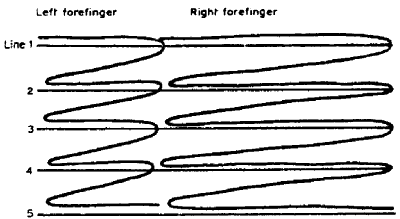 |
Science Frontiers ONLINE No. 48: Nov-Dec 1986 |
|
|
Braille And The Brain
The human brain apparently can handle more than one stream of input data simultaneously, as shown by J. Hartley's studies of Braille readers.
"A chance observation of a skilled blind reader led me to think that reading braille might provide a more natural task for studying the way in which people do two things at once. My studies of my colleague Lewis Jones suggest that he appears to use some form of parallel processing. Jones cannot recall whether or not he was taught to read Braille with two hands, but in common with other skilled readers of Braille, he has done so for many years. Jones' method of reading is typically as follows. The left forefinger starts to read the beginning of the line. It then meets the the right forefinger returning from the line above. When the two fingers touch, the right forefinger continues to read the line while the left forefinger returns to the beginning of the next line. The whole operation is quite smooth and cyclical, as the diagram...shows. However, I was startled to observe that the left forefinger starts to read the next line before the right forefinger has finished the line above. This overlap, demonstrated by my crude data, suggests that Jones appears to be using some form of parallel processing: it seems as if his brain stores initial information from his left forefinger before using it."
S. Miller, at Oxford, has also investigated Braille readers. She questions whether the left forefinger actually starts processing data before the right forefinger has finished the line above. She thinks the left forefinger may just be homing in on the space preceding the first letter. However, Miller agrees that the two fingers are moving in different places at the same time.
(Hartley, James; "Braille and the Brain," New Scientist, p. 34, August 7, 1986.)
